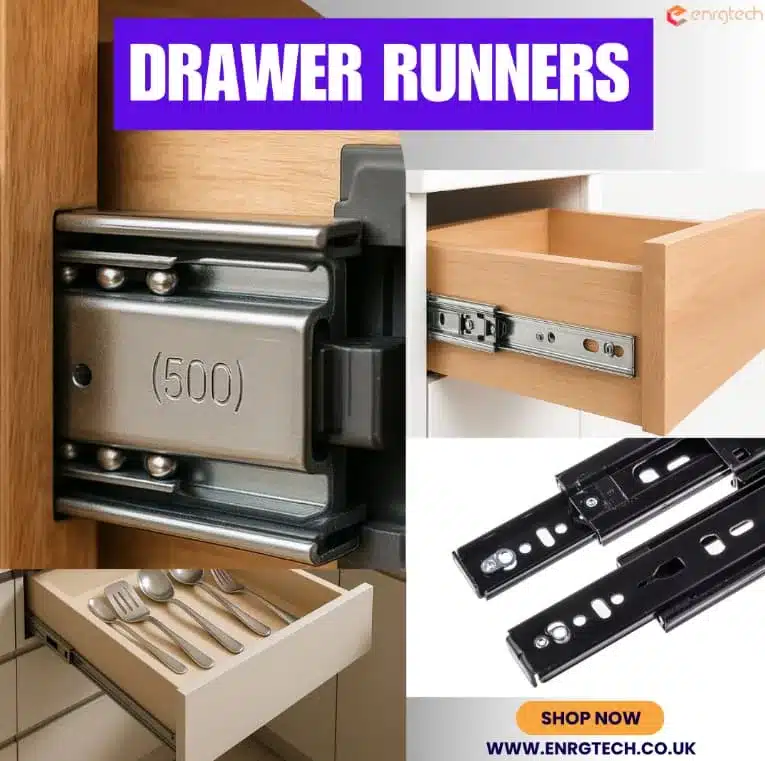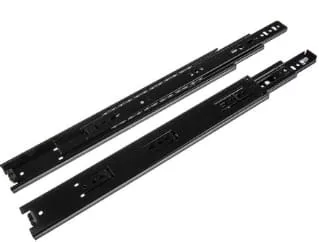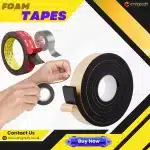
Introduction
A great cabinet is only as good as its drawers. And the secret to a smooth, functional drawer lies in its runners. A humble drawer runner is a component we interact with countless times a day, yet it remains largely unnoticed. We realise its significance when a drawer jams, sticks, or falls off its track. This guide lifts the curtain on drawer runners, the backbone of any functional cabinetry, and covers their popular types, functionality, and crucial factors to consider when selecting the best one for your needs.
What is a Drawer Runner? Definition and Core Functionality
A drawer runner, also referred to as a drawer slide or drawer glider, is a mechanical component that enables a linear movement of a drawer to slide smoothly. These mechanical devices are available in various materials, load capacities, mounting options, and extension mechanisms. Typically installed in pairs, drawer runners roll against each other, allowing a drawer to move in and out of a piece of furniture. A drawer runner offers a neat and ergonomic storage solution across kitchens, offices, workshops, and retail settings.
The core functionality of a drawer runner is to provide an efficient, stable, quiet, and low-friction pathway for the drawer’s movement, preventing it from binding or tilting. They also support weight, protect drawers from friction and damage, influence noise, safety, and the overall life of furniture.
The Importance of Drawer Runners in Furniture & Storage Systems
Drawer runners are significant in modern interiors, furniture, and storage systems. Without quality runners, drawers may stick, wobble, or wear out prematurely, compromising user experience and structural integrity. Most notably, drawer gliders enable drawers to slide smoothly in and out of furniture. They not only provide convenience but also improve durability and prevent wear on wooden joints. Beyond mere convenience, drawer runners provide critical structural support, preventing drawers from sagging, tilting, or coming loose over time.
Types You Will Find in the Market: A Brief Overview
Drawer runners are primarily categorised by their mechanism, materials, motion features, extension, load capacity, and mounting position. Some of the standard types available in the market include:
Roller Runners
Also known as European-style slides, these are the most basic and economical option. They consist of two members, one with a roller at the front and the other with a roller at the back, which track each other.
Ball-Bearing Runners
These are the workhorses of the modern cabinet world. They use a telescopic design with steel ball bearings to provide an exceptionally smooth and quiet motion.
Under-Mount, Centre-Mount, and Side-Mount Runners
As the name suggests, under-mount runners are designed to mount to the underside of the drawer box. With a clean, high-end look, under-mount runners are the ultimate choice as they are completely invisible when the drawer is open. Centre-mounted models are installed beneath the centre of the drawer. They are affordable and straightforward but offer less stability for wider drawers. Side-mounted runners are attached to the sides of the drawer and cabinet. They are cost-effective, easy to install, and commonly used in office furniture and kitchen cabinets.
Soft-Close Runners
A soft-close drawer runner comes with a built-in damping mechanism that catches the drawer in the last few inches of travel and pulls it shut gently and silently. This prevents slamming and is a highly desirable feature in kitchens.
Self-Close Runners
These feature a simpler spring-based mechanism that pulls the drawer shut once it reaches a certain point. It does not have the damping effect of a soft-close mechanism and will still produce a “click” sound.
Push-to-Open (or Touch-Release) Runners
A push-to-open drawer runner integrates a spring-loaded mechanism that pops the drawer open when you press on its face. This is essential for creating a modern, handle-less cabinet design.
Metal and Plastic Drawer Runners
These are durable and strong options, suitable for heavy loads. Steel runners with anti-rust coatings are widely used. Plastic runners are lightweight and budget-friendly choices, though not as durable. Hybrid models are also available that combine metal with plastic rollers for balance.
Heavy-duty and industrial Runners
Heavy-duty runners are reinforced members with larger bearings and thicker steel. They are ideal for supporting high loads, such as tool cabinets, battery drawers, power equipment trays, retail or warehouse bins, and service vans.
Drawer Runners vs. Drawer Slides – Are They Different?
While drawer runners and drawer slides are often used interchangeably, they have slight differences between them. The distinction lies in their mechanisms, depending on regional terminology and manufacturer preferences. Technically, both serve the same purpose—facilitating the smooth opening and closing of drawers. However, a drawer runner usually emphasises the guiding track or rail system that may include the entire assembly. On the other hand, a drawer slidemore specifically refers to the sliding mechanism or motion hardware itself. In practice, both mean the same thing. Additionally, in the UK, drawer runner is more commonly used, whereas drawer slide is the preferred term in the US.
Buying Guide: Key Parameters When Choosing the Right Drawer Runner
Choosing the right drawer runner is crucial for the functionality, durability, and aesthetics of any drawer system. The wrong choice can lead to frustrating issues like sagging, sticking, or even a complete breakdown. To make an informed decision and pick the best one, consider these key parameters:
- Type of Runner
- Weight Capacity (Load Rating)
- Extension Mechanism and Travel
- Mounting Style
- Material & Finish
- Dimensions
- Soft-Close/Push-to-Open Features
- Locking Mechanism
- Installation Compatibility
- Brand and Cost.
Final Thoughts
Drawer runners are more than just functional hardware; they are a critical component that defines the quality and feel of a piece of furniture. These mechanical devices are a foundational element in functional furniture and storage design, enhancing user experience. With numerous options available, selecting the right type, material, and load capacity, and installing them correctly can significantly improve the usability and lifespan of any drawer system.























